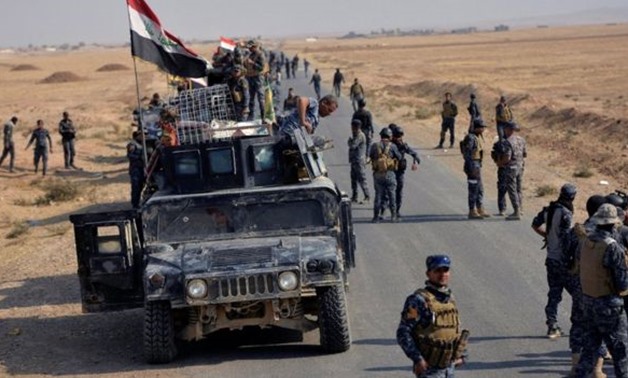
Iraqi forces in the Battle of Mosul - File photo
The year was 2003, the month August, and the US-led invasion of Iraq had concluded its initial phase. The Ba’ath Party had been overcome, and the U.N. Assistance Mission to Iraq was founded to support national development and provide key humanitarian and political support. In stark contrast to the Green Zone, a secure area which epitomized the occupation, the U.N. office at the Canal Hotel was open and free-flowing. This was not to last. Five days after its launch, a truck pulled up outside the Canal Hotel and exploded, killing at least twenty-two people inside and wounding many dozens more. This was the first confirmed attack by Abu Musab al-Zarqawi’s organization – Jama'at al-Tawhid wal-Jihad.
Its existence in Iraq was as a fierce insurgency group, indiscriminately attacking foreign forces as well as Shi’a militias and civilians. Al-Zarqawi was infamously credited with transforming the counter-coalition insurgency into a sectarian war. His sectarian flames added to the fire in Iraq, which was burning ferociously out of control.
Ten years and several name changes later, Abu Bakr al-Baghdadi renamed the organization the Islamic State in Iraq and the Levant, and the group that the world has grown to fear began their most audacious campaign.
In June 2014, and a name change once again, the Islamic State (IS) was propelled into a different league as they dominated a territory the size of Great Britain. This included many major cities and strategic points, most notably Iraq’s second city, Mosul. With an estimated annual income of $1-2 billion and a fighting force of 30,000, they enforced their strict and brutal form of Salafist Islam upon eight million subjects.
The campaign against IS has been fierce. Domestic forces have joined forces with international powers in a manner unthinkable before. Not only has the U.S. been funding the Kurdish YPG in their fight against IS in Raqqa, but on both sides of the isle, local militias have coordinated with international powers to unleash a brutal air campaign against IS.
This anti-IS campaign has been largely effective.
A report by IHS Conflict Monitor in June 2017 stated that IS had lost more than 60% of the territory it controlled in Iraq and Syria in January 2015.
IS are close to losing their de facto capital in Raqqa, which is indicative of a larger problem for the terrorist group as they struggle to maintain a heavy-handed grip on any territorial space.
A recently released report titled “The Fight Goes on: the Islamic State’s Continuing Military Efforts in Liberated Cities” has monitored the military activity of IS in cities liberated from their control.
Although ending their direct oppression, the report indicates that ousting IS from their territory will simply spark a new era in the war.
The results of this report indicate a change in IS’s tactics. A terrorist group that once governed vast swathes of territory across Iraq and Syria has reverted to its insurgency roots, once again attempting to fuel a sectarian conflict.
What is increasingly evident in Iraq is that attacks on liberated areas are being committed in areas where IS believes they can fuel sectarian tensions.
The first and fourth cities with the most attacks by IS per month since their liberation, W. Mosul and Sinjar, lie in the Ninawa Province. A highly multiethnic province, yet dominated by Sunni’s, is the ideal place for IS to fuel sectarian tensions, since it is dominated by a Sunni population, which allows for a broad possible support base, providing IS with a minority group to use as a scapegoat, alienate and oppress.
The case is the same in al-Anbar Province, including Ramadi and Rutba, which occupy the third and fifth place on this list respectively. Again, this case is replicated in Baiji, a city located in the Salahuddin Province, which sits second in the list.
In all three provinces, the vast majority of attacks were committed against Iraqi military forces and Shiite militias.
In territories liberated from IS control in Syria, they committed an average of 2.46 attacks each month. However, in stark contrast, the average number of attacks committed each month in Iraq stood at 16.56. Yet, attacks on previously held territory in Syria have been wholly more effective, with each attack killing an estimated 7.56 and 1.9 people in Syria and Iraq respectively. What makes Iraq so appealing to IS? So appealing that Iraq has experienced a 7x greater threat from IS as they attempt to regain lost territory?
It is clear IS is attempting to regain their long-lasting influence in Iraq. Although this was first attempted as part of their audacious caliphate, evidently this was unsustainable. As the multifaceted war in Syria burns out of control, IS wants to reignite the dying embers of the insurgency that consumed Iraq during the US-led occupation.
For too long, the alienating policies of ex-Premier al-Maliki inevitably led to the fall of Mosul and a third of Iraqi territory. For too long, Sunnis felt oppressed by al-Maliki’s nepotism and corruption. For too long, al-Maliki’s inadequate military leadership failed much of the population.
This manifested itself during IS’s capture of Mosul, where many Sunni soldiers laid down their arms and submitted to IS – al-Maliki’s premiership came to an unavoidable end.
As a coordinated effort is gaining success in expelling IS from its territory, the terrorist group is attempting to rally Sunnis and rekindle their desire for collective supremacy over Iraq. To avoid IS replicating their previous success through a sustained underground insurgency, the ethnic and religious pendulum in Iraq is in desperate need of re-balancing.

Comments
Leave a Comment